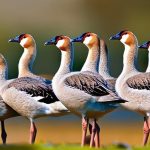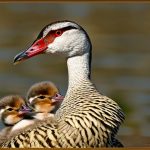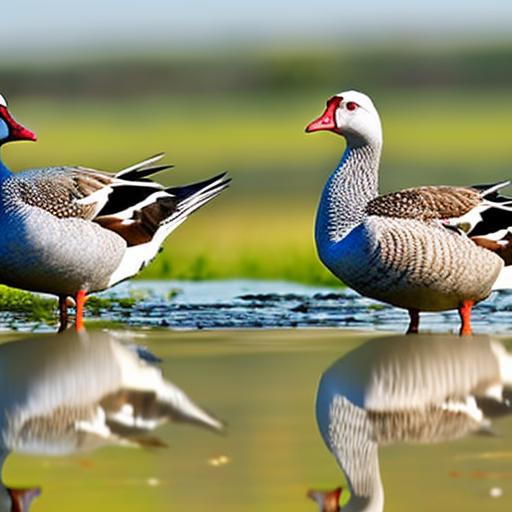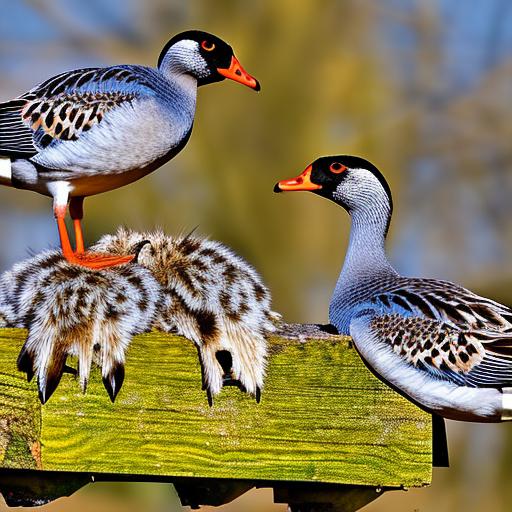Giant goose breeds are a fascinating and unique group of domesticated geese known for their impressive size and striking appearance. These majestic birds are often sought after for their large size, which can make them an impressive addition to any farm or homestead. There are several different breeds of giant geese, each with its own distinct characteristics and traits. From the imposing Toulouse Goose to the regal Embden Goose, these birds are a popular choice for those looking to add a touch of grandeur to their flock.
Giant goose breeds are not only known for their size, but also for their gentle nature and friendly disposition. They are often raised for their meat, eggs, and down, making them a valuable addition to any farm. In addition to their practical uses, giant geese are also popular for their ornamental value, as they make a stunning addition to any landscape with their graceful presence and striking plumage. Whether you are a seasoned farmer or a novice enthusiast, giant goose breeds are a captivating and rewarding addition to any flock.
Characteristics of the Largest Goose Breeds
The largest goose breeds are known for their impressive size and striking appearance. One of the most well-known giant goose breeds is the Toulouse Goose, which can weigh up to 30 pounds and stand over 3 feet tall. These birds have a distinctive appearance, with a broad chest, long neck, and a prominent knob at the base of their bill. Another popular giant goose breed is the Embden Goose, which is known for its pure white plumage and large size. These birds can weigh up to 25 pounds and are prized for their calm and gentle nature.
In addition to their size, giant goose breeds are also known for their excellent foraging abilities and hardy nature. They are well-suited to a variety of climates and can thrive in both rural and urban environments. Giant geese are also known for their strong maternal instincts, making them excellent parents and caretakers of their young. With their impressive size, striking appearance, and gentle disposition, it’s no wonder that giant goose breeds are a popular choice for farmers and enthusiasts alike.
The History and Origins of Giant Goose Breeds
The history of giant goose breeds can be traced back to ancient times, with evidence of domesticated geese dating back thousands of years. The Toulouse Goose, one of the largest goose breeds, has its origins in the region of Toulouse, France, where it was first bred for its meat and down. The Embden Goose, another popular giant breed, hails from the town of Emden in Germany, where it was prized for its large size and excellent foraging abilities.
Giant goose breeds have played an important role in agriculture throughout history, providing valuable meat, eggs, and down to farmers and homesteaders. They were also used as guard animals, alerting farmers to potential threats with their loud honking and imposing presence. Today, giant goose breeds continue to be valued for their practical uses as well as their ornamental value, making them a cherished part of many farms and homesteads around the world.
Popular Uses for Giant Goose Breeds
Giant goose breeds are valued for a variety of practical uses, making them a popular choice for farmers and homesteaders. One of the most common uses for giant geese is for meat production. Their large size makes them an excellent source of high-quality meat, which is prized for its rich flavor and tender texture. In addition to meat production, giant geese are also valued for their eggs, which are larger than those of standard-sized geese and have a rich, flavorful yolk.
Another popular use for giant goose breeds is for down production. The down of giant geese is highly prized for its warmth and insulating properties, making it an ideal material for bedding, pillows, and winter clothing. In addition to their practical uses, giant geese are also valued for their ornamental value, as they make a stunning addition to any landscape with their graceful presence and striking plumage. Whether you are looking for a practical addition to your farm or a captivating ornamental bird, giant goose breeds are a versatile and rewarding choice.
Challenges and Considerations for Raising Giant Goose Breeds
While raising giant goose breeds can be a rewarding experience, it also comes with its own set of challenges and considerations. One of the main challenges of raising giant geese is their large size, which requires ample space and resources to accommodate their needs. It’s important to provide them with plenty of room to roam and graze, as well as access to fresh water and nutritious feed.
Another consideration when raising giant goose breeds is their strong maternal instincts. While this can be a positive trait in many ways, it can also lead to aggression towards humans or other animals if they feel threatened or protective of their young. It’s important to handle giant geese with care and respect, especially during breeding season when they may be more protective of their nests and offspring.
In addition to these challenges, it’s important to consider the specific needs and requirements of each breed when raising giant geese. Some breeds may have specific dietary needs or health considerations that need to be taken into account. By understanding the unique characteristics and traits of each breed, you can ensure that your giant geese are happy, healthy, and thriving.
Breeding and Caring for Giant Goose Breeds
Breeding and caring for giant goose breeds requires careful attention to their specific needs and requirements. When breeding giant geese, it’s important to select healthy, well-matched pairs that exhibit the desired traits and characteristics of the breed. It’s also important to provide them with a suitable nesting area where they can lay and incubate their eggs in peace.
Once the eggs hatch, it’s important to provide the goslings with proper care and nutrition to ensure that they grow into healthy adults. This includes providing them with a warm and safe environment, as well as access to nutritious feed and clean water. It’s also important to handle the goslings with care and gentleness to ensure that they grow up to be friendly and well-socialized adults.
In addition to breeding considerations, caring for giant goose breeds also requires regular maintenance and attention to their health and well-being. This includes providing them with regular access to fresh water, nutritious feed, and suitable shelter from the elements. It’s also important to monitor their health closely and seek veterinary care if any issues arise. By providing your giant geese with proper care and attention, you can ensure that they lead happy and healthy lives.
The Future of Giant Goose Breeds
Giant goose breeds have a rich history and continue to be valued for their practical uses as well as their ornamental value. As more people become interested in sustainable agriculture and self-sufficiency, giant geese are likely to continue to be a popular choice for farmers and homesteaders around the world. With their impressive size, striking appearance, and gentle disposition, giant goose breeds are a captivating and rewarding addition to any flock.
As we look towards the future of giant goose breeds, it’s important to continue to prioritize their health and well-being while also preserving their unique characteristics and traits. By understanding the specific needs and requirements of each breed, we can ensure that giant geese continue to thrive for generations to come. Whether you are looking for a practical addition to your farm or a captivating ornamental bird, giant goose breeds are a versatile and rewarding choice that is sure to bring joy and beauty to any landscape.
Meet Walter, the feathered-friend fanatic of Florida! Nestled in the sunshine state, Walter struts through life with his feathered companions, clucking his way to happiness. With a coop that’s fancier than a five-star hotel, he’s the Don Juan of the chicken world. When he’s not teaching his hens to do the cha-cha, you’ll find him in a heated debate with his prized rooster, Sir Clucks-a-Lot. Walter’s poultry passion is no yolk; he’s the sunny-side-up guy you never knew you needed in your flock of friends!







